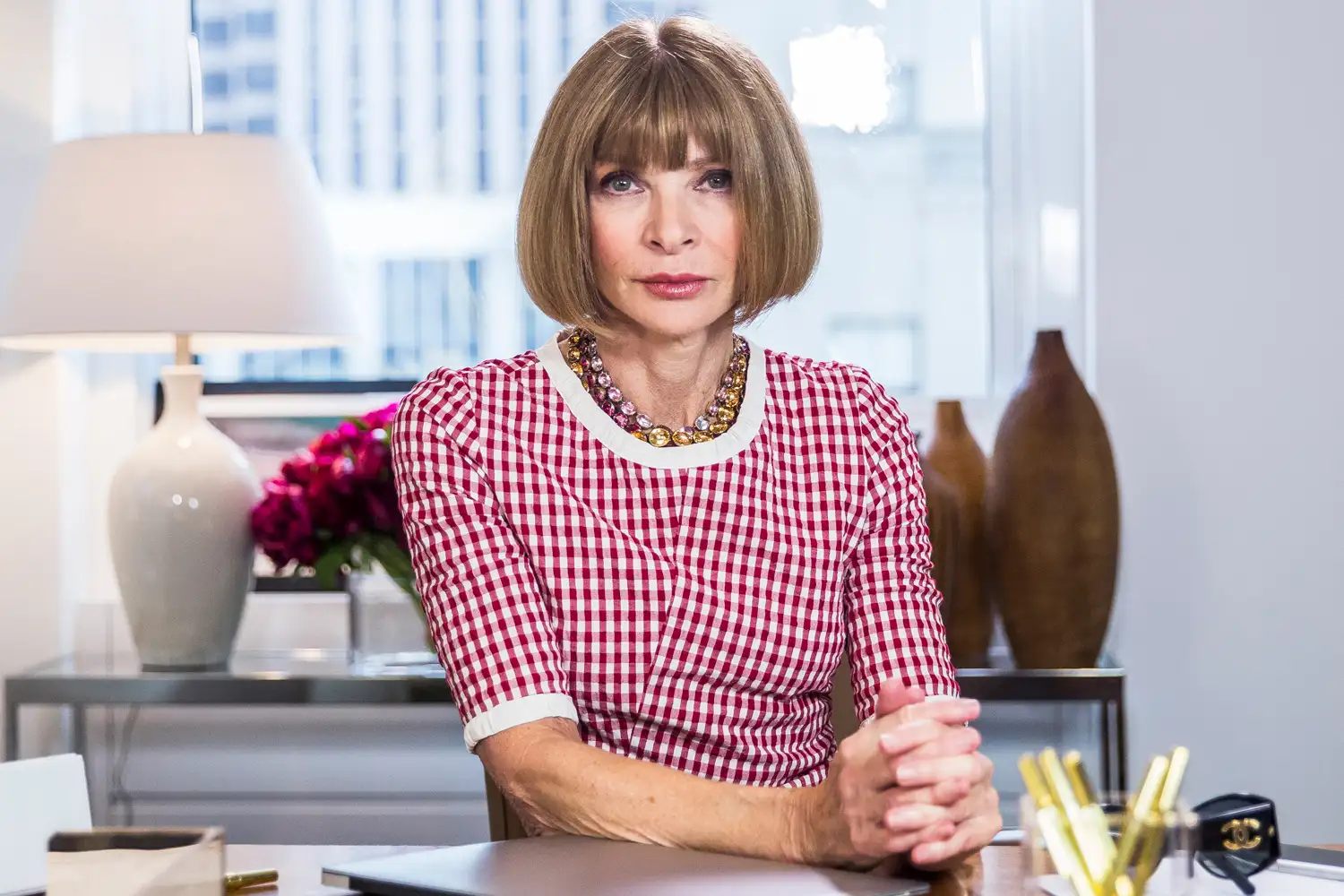For nearly four decades, the name Anna Wintour has been synonymous with Vogue, the undisputed bible of fashion. Her distinctive bob haircut and ever-present dark sunglasses became as iconic as the magazine itself, signaling an era of unparalleled influence and often, fierce authority within the global fashion landscape.
Her tenure as editor-in-chief of Vogue, a remarkable 37-year run, has fundamentally reshaped not just the publication, but the entire industry. However, a significant announcement on June 26, 2025, marked a new chapter: Anna Wintour is formally stepping down from her iconic role as Vogue’s editor-in-chief.
This news, reported by multiple prominent outlets including Business of Fashion, The Daily Front Row, and WWD, sent ripples through the fashion world. Wintour herself delivered the surprising revelation during a morning staff meeting, signaling a strategic shift rather than a full departure. Her decision is part of a broader evolution within Condé Nast, the media giant that owns Vogue. While the immediate headlines might suggest a retirement, Wintour is far from leaving the publishing empire.
Instead, she is embracing an expanded and arguably even more powerful global leadership position within Condé Nast. This pivotal move highlights not only Wintour’s enduring presence but also the changing dynamics of traditional media in a digitally driven world. The question on everyone’s mind is not if she’s leaving, but why this shift now, and what it truly means for Vogue and the wider fashion realm.
The Evolution of a Legend: Wintour’s Impact and Influence
Anna Wintour’s nearly four-decade reign at Vogue transformed the magazine into a cultural powerhouse, and her influence extended far beyond its glossy pages.
Reshaping the Fashion Magazine Landscape
Anna Wintour joined Vogue in 1988, stepping into a role that was already prestigious but which she would redefine entirely. From the outset, Wintour was eager to inject new energy and a fresh perspective into the American fashion magazine. As she told her Vogue staff, “When I became the editor of Vogue, I was eager to prove to all who might listen that there was a new, exciting way to imagine an American fashion magazine.” This vision led to several historic moves that profoundly reshaped the fashion industry.
One of her most significant and now standard practices was the featuring of celebrities on the cover of Vogue. Before Wintour, fashion magazines predominantly showcased supermodels. Her decision to place Hollywood stars and public figures on the cover was revolutionary. This move dramatically increased the magazine’s cultural relevance and commercial appeal, bridging the gap between high fashion and mainstream popular culture.
It also allowed Vogue to comment on broader societal trends. Beyond covers, Wintour was known for her discerning eye, championing emerging designers, and pushing the boundaries of fashion photography. She curated a unique blend of aspirational luxury with an understanding of contemporary street style, making Vogue both a guide and a reflection of the times. Her precise editorial direction ensured that Vogue remained at the pinnacle of fashion journalism, a powerful arbiter of style and taste globally.
The “Devil Wears Prada” and Beyond
Anna Wintour’s formidable reputation and exacting standards became the stuff of legend, inspiring one of the most famous cultural portrayals of a fashion editor. Her widely acknowledged influence is believed to have been the primary inspiration for Miranda Priestly, the intimidating and powerful editor-in-chief played by Meryl Streep in the critically acclaimed 2006 film, The Devil Wears Prada.
The film was adapted from a novel by Lauren Weisberger, who famously served as Wintour’s former assistant. This fictionalized depiction, complete with meticulous demands, sharp critiques, and an unwavering commitment to perfection, solidified Wintour’s persona in the public imagination, creating a lasting cultural touchstone.
Beyond the silver screen, Wintour’s career continued to expand within the Condé Nast empire, reflecting her increasing power and strategic importance to the company. In 2013, she was named Condé Nast’s artistic director, a role that extended her influence across multiple brands within the publishing house. This elevation signified her pivotal role in shaping the overall creative vision for the company.
Her portfolio further expanded in 2019 when she was appointed the company’s global content advisor. These successive promotions laid the groundwork for her most recent shift, demonstrating a continuous trajectory towards broader strategic oversight rather than a singular editorial focus on Vogue alone. Her journey illustrates a remarkable career arc from a singular magazine editor to a global media executive, constantly adapting and expanding her sphere of influence.
The Strategic Shift: Why Wintour’s Role is Evolving
Anna Wintour’s decision to step down from the editor-in-chief role is not a retirement, but a strategic move that aligns with Condé Nast’s evolving global structure.
Expanded Global Responsibilities
The primary reason for Anna Wintour’s decision to step down as editor-in-chief of Vogue is directly related to her expanded responsibilities across Condé Nast over the last four years. Vogue itself reported that relinquishing the day-to-day editorial duties of the American edition will provide her with significantly more time to support the company’s global titles and events. This is a strategic move by Condé Nast to centralize and streamline its global content operations.
This shift is reportedly part of a broader restructuring initiative at Condé Nast. According to The Hollywood Reporter, this global reorganization has involved a significant shift in editorial leadership across the company’s portfolio. Specifically, each of Condé Nast’s global editorial brands has installed an editorial director in each country or market. Crucially, these regional directors then report to a global editorial director who oversees all of them. This new framework aims to ensure consistency, synergy, and a unified creative vision across all international editions of Condé Nast titles.
In line with this new global structure, Wintour will continue to play a pivotal and overarching role: she will stay on as the global editorial director of Vogue. This means she will still hold significant power and influence over the direction and content of Vogue worldwide, ensuring her vision continues to shape the brand on a truly international scale. Her move is less about relinquishing control and more about focusing her formidable energy on a larger, more impactful strategic role.
A New Generation of Leadership
Wintour’s decision also reflects a commitment to nurturing the next generation of talent within the industry. This was a sentiment she explicitly shared with her staff during the announcement. She stated, “Anybody in a creative field knows how essential it is never to stop growing in one’s work.” This growth, for her, now means fostering new ideas and leadership. She continued, “Now, I find that my greatest pleasure is helping the next generation of impassioned editors storm the field with their own ideas, supported by a new, exciting view of what a major media company can be.”
This philosophy underscores a shift in focus for Wintour from daily operational oversight to a more mentorship-driven and strategic advisory role. While Vogue has not yet announced who will fill the void left by her departure from the editor-in-chief title, the outlet confirmed that the new person in charge will report directly to Wintour. This clearly indicates her continued authority and oversight. Furthermore, a significant change accompanies this transition: the long-standing title of “editor-in-chief” will no longer exist for the American Vogue. Instead, Wintour’s replacement will be known as the “head of editorial content,” as reported by The New York Times.
This new title reflects the broader Condé Nast restructuring, which aims to have global editorial directors (like Wintour) overseeing regional heads of editorial content. This structural change emphasizes a more integrated, globally coordinated approach to content creation, where regional leaders manage day-to-day operations under the strategic guidance of a global visionary like Anna Wintour. This ensures fresh perspectives at the helm of individual publications while maintaining a cohesive brand identity under Wintour’s experienced leadership.
Defying Retirement Rumors: Wintour’s Enduring Passion
Despite decades of speculation, Anna Wintour has consistently rebuffed rumors of her retirement, affirming her deep-seated passion for her work and the industry.
Decades of Dismissed Speculation
The notion of Anna Wintour stepping down from Vogue is far from new; rumors of her retirement have circulated for decades. Yet, each time, Wintour has firmly dismissed them, often with characteristic wit and determination. A notable instance occurred in a 2009 interview on 60 Minutes, where she was directly asked if she thought it was time to say goodbye to her role.
Her response was unequivocal: “Not at all.” She elaborated on her commitment, stating, “To me, this is a really interesting time to be in this position. I think it would be in a way irresponsible not to put my best foot forward and lead us into a different time.” This unwavering dedication reflects her profound belief in the evolving role of media and her responsibility to guide Vogue through changing landscapes.
Wintour has consistently maintained that her departure, when it eventually happens, would be a quiet affair. She famously said that when the time comes for her to step down, she would do so “very quietly.” This current, highly publicized shift, while a significant change in title, aligns with her long-held desire to remain involved and influential, rather than to simply disappear. More recently, in February 2025, when Wintour was recognized as a Companion of Honour by King Charles, the monarch reportedly asked her if she had plans to retire.
Her response, as she recounted to The Independent, was equally resolute: “The last time I was here, [Queen Elizabeth] gave me a medal, and we both agreed that we had been doing our job a very long time. And then this morning, His Majesty asked me if this meant I was going to stop working, and I said firmly, ‘No.’ ” She added that the honor made her “even more convinced” that she has “so much more to achieve.” These consistent affirmations highlight her enduring passion and boundless energy, demonstrating that her recent title change is a strategic evolution, not a graceful exit from the industry.
Her Vision for the Future of Vogue
Anna Wintour’s vision for the future of Vogue is one of dynamism and innovation, even as her role evolves. While she relinquishes the daily oversight of the American edition, she remains deeply invested in the brand’s global trajectory and its most impactful ventures. She articulated her excitement for the future to her staff, saying, “How thrilling it will be to work alongside someone new who will challenge us, inspire us, and make us all think about Vogue in a myriad of original ways.” This statement indicates her desire for fresh perspectives to infuse the magazine, fostering an environment of continuous creativity.
Her own commitments remain robust. Vogue reported that Wintour will definitively stay on as its global editorial director. This means her involvement in flagship events and innovative projects will remain unchanged. Specifically, her critical role in the Met Ball (the annual Costume Institute Gala, which she has co-chaired for decades and transformed into fashion’s biggest night), Vogue World (the magazine’s ambitious global fashion and cultural event series), and “any other original fearless ideas” will continue unabated. Furthermore, in a touch of personal flair, she jokingly told her staff that she’ll “remain Vogue’s tennis and theater editor in perpetuity,” highlighting her personal passions and perhaps a playful nod to her enduring presence.
Crucially, she will also continue to serve as Condé Nast’s global chief content officer, a role that places her at the very top of the company’s editorial hierarchy. In this capacity, she will oversee the content strategy for nearly all of Condé Nast’s other prestigious media brands, including Vanity Fair, GQ, Teen Vogue, WIRED, and many others, with the exception of The New Yorker. Her offices will not even change, as she famously stated, “I won’t be moving offices — or a single piece of my Clarice Cliff pottery.” This ensures her direct access and influence over the broader Condé Nast portfolio, confirming that her “stepping down” is, in reality, a strategic ascent to an even broader and more influential role within the global media empire.
Wintour’s Lasting Legacy and New Horizon
Anna Wintour’s shift from Editor-in-Chief of Vogue marks the end of an extraordinary 37-year era for the iconic American fashion magazine. However, this is far from a retirement. Instead, it represents a strategic evolution of her already vast influence within Condé Nast, aligning with the company’s global restructuring efforts. Wintour’s new focus as Global Editorial Director of Vogue and Global Chief Content Officer for Condé Nast ensures her continued leadership over a vast media empire.
Her decision paves the way for new leadership at the helm of American Vogue, albeit under the revised title of “head of editorial content” and reporting directly to her. This move allows Wintour to dedicate more time to nurturing emerging talent and overseeing the global vision of Vogue and Condé Nast’s other prestigious titles.
Her legacy of innovation, from celebrity covers to the Met Gala’s transformation, is indelible. Despite decades of retirement rumors, Wintour’s enduring passion for media and fashion remains evident. Her new, expansive role underscores her commitment to shaping the industry for generations to come, proving that the woman behind the iconic bob and sunglasses is still very much at the pinnacle of power.








